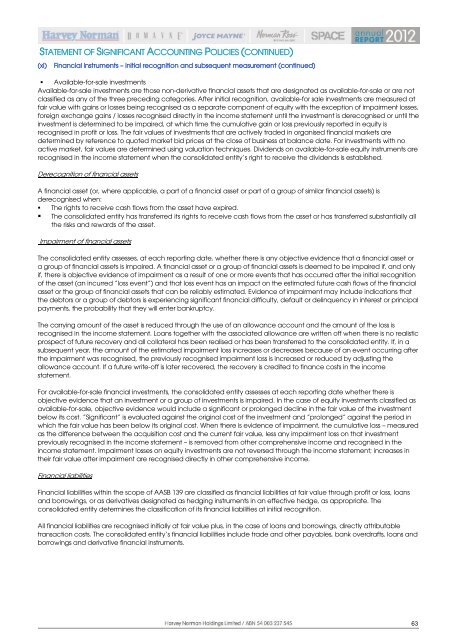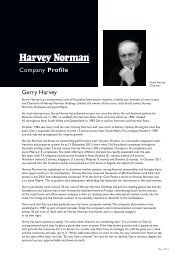annual report - Harvey Norman Company Reports & Announcements
annual report - Harvey Norman Company Reports & Announcements
annual report - Harvey Norman Company Reports & Announcements
Create successful ePaper yourself
Turn your PDF publications into a flip-book with our unique Google optimized e-Paper software.
STATEMENT OF SIGNIFICANT ACCOUNTING POLICIES (CONTINUED)<br />
(xi) Financial instruments – initial recognition and subsequent measurement (continued)<br />
Available-for-sale investments<br />
Available-for-sale investments are those non-derivative financial assets that are designated as available-for-sale or are not<br />
classified as any of the three preceding categories. After initial recognition, available-for sale investments are measured at<br />
fair value with gains or losses being recognised as a separate component of equity with the exception of impairment losses,<br />
foreign exchange gains / losses recognised directly in the income statement until the investment is derecognised or until the<br />
investment is determined to be impaired, at which time the cumulative gain or loss previously <strong>report</strong>ed in equity is<br />
recognised in profit or loss. The fair values of investments that are actively traded in organised financial markets are<br />
determined by reference to quoted market bid prices at the close of business at balance date. For investments with no<br />
active market, fair values are determined using valuation techniques. Dividends on available-for-sale equity instruments are<br />
recognised in the income statement when the consolidated entity‟s right to receive the dividends is established.<br />
Derecognition of financial assets<br />
A financial asset (or, where applicable, a part of a financial asset or part of a group of similar financial assets) is<br />
derecognised when:<br />
The rights to receive cash flows from the asset have expired.<br />
The consolidated entity has transferred its rights to receive cash flows from the asset or has transferred substantially all<br />
the risks and rewards of the asset.<br />
Impairment of financial assets<br />
The consolidated entity assesses, at each <strong>report</strong>ing date, whether there is any objective evidence that a financial asset or<br />
a group of financial assets is impaired. A financial asset or a group of financial assets is deemed to be impaired if, and only<br />
if, there is objective evidence of impairment as a result of one or more events that has occurred after the initial recognition<br />
of the asset (an incurred ”loss event”) and that loss event has an impact on the estimated future cash flows of the financial<br />
asset or the group of financial assets that can be reliably estimated. Evidence of impairment may include indications that<br />
the debtors or a group of debtors is experiencing significant financial difficulty, default or delinquency in interest or principal<br />
payments, the probability that they will enter bankruptcy.<br />
The carrying amount of the asset is reduced through the use of an allowance account and the amount of the loss is<br />
recognised in the income statement. Loans together with the associated allowance are written off when there is no realistic<br />
prospect of future recovery and all collateral has been realised or has been transferred to the consolidated entity. If, in a<br />
subsequent year, the amount of the estimated impairment loss increases or decreases because of an event occurring after<br />
the impairment was recognised, the previously recognised impairment loss is increased or reduced by adjusting the<br />
allowance account. If a future write-off is later recovered, the recovery is credited to finance costs in the income<br />
statement.<br />
For available-for-sale financial investments, the consolidated entity assesses at each <strong>report</strong>ing date whether there is<br />
objective evidence that an investment or a group of investments is impaired. In the case of equity investments classified as<br />
available-for-sale, objective evidence would include a significant or prolonged decline in the fair value of the investment<br />
below its cost. ”Significant” is evaluated against the original cost of the investment and ”prolonged” against the period in<br />
which the fair value has been below its original cost. When there is evidence of impairment, the cumulative loss – measured<br />
as the difference between the acquisition cost and the current fair value, less any impairment loss on that investment<br />
previously recognised in the income statement – is removed from other comprehensive income and recognised in the<br />
income statement. Impairment losses on equity investments are not reversed through the income statement; increases in<br />
their fair value after impairment are recognised directly in other comprehensive income.<br />
Financial liabilities<br />
Financial liabilities within the scope of AASB 139 are classified as financial liabilities at fair value through profit or loss, loans<br />
and borrowings, or as derivatives designated as hedging instruments in an effective hedge, as appropriate. The<br />
consolidated entity determines the classification of its financial liabilities at initial recognition.<br />
All financial liabilities are recognised initially at fair value plus, in the case of loans and borrowings, directly attributable<br />
transaction costs. The consolidated entity‟s financial liabilities include trade and other payables, bank overdrafts, loans and<br />
borrowings and derivative financial instruments.<br />
63



